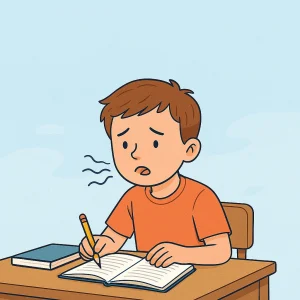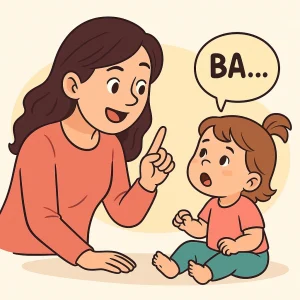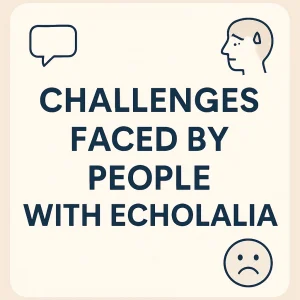Understanding Masking in Autism: When Kids Hide Their Traits
By Rajini D
Last Updated: April 14, 2025
Autism Spectrum Disorder (ASD) is a complex developmental condition marked by challenges in social interaction, speech, non-verbal communication, and repetitive behaviors. One aspect of autism that often goes unnoticed is “masking,” where individuals with autism consciously or unconsciously conceal their autistic traits to fit into social norms. This adaptive strategy helps them navigate social landscapes but can also lead to significant emotional and mental stress.
Recognizing when a child is masking their autistic traits is crucial. It allows parents, educators, and therapists to provide the appropriate support and understanding that these children need. By identifying and addressing masking behaviors early, we can help alleviate the potential stress and isolation these children might feel and foster a more supportive environment that celebrates their unique perspectives and skills.
What is Masking in Autism?
Masking in autism is a complex behavior where individuals with autism spectrum disorder (ASD) attempt to hide or suppress their natural autistic characteristics to blend into social settings. This can involve mimicking neurotypical behaviors, suppressing stimming (self-stimulatory behaviors such as flapping, rocking), or hiding their difficulties in social interactions. Often referred to as “camouflaging,” this process is both conscious and unconscious, serving as a coping mechanism to navigate a world that is predominantly designed for neurotypical individuals.
Why Do Some Children with Autism Choose to Mask Their Traits?
Children with autism may choose to mask their traits for various reasons, primarily revolving around the desire to fit in with their peers, avoid bullying, or meet the expectations of their social environments. From a young age, children may recognize that their natural behaviors make them stand out, and in response, they might start to suppress these traits to elude negative attention or criticism.
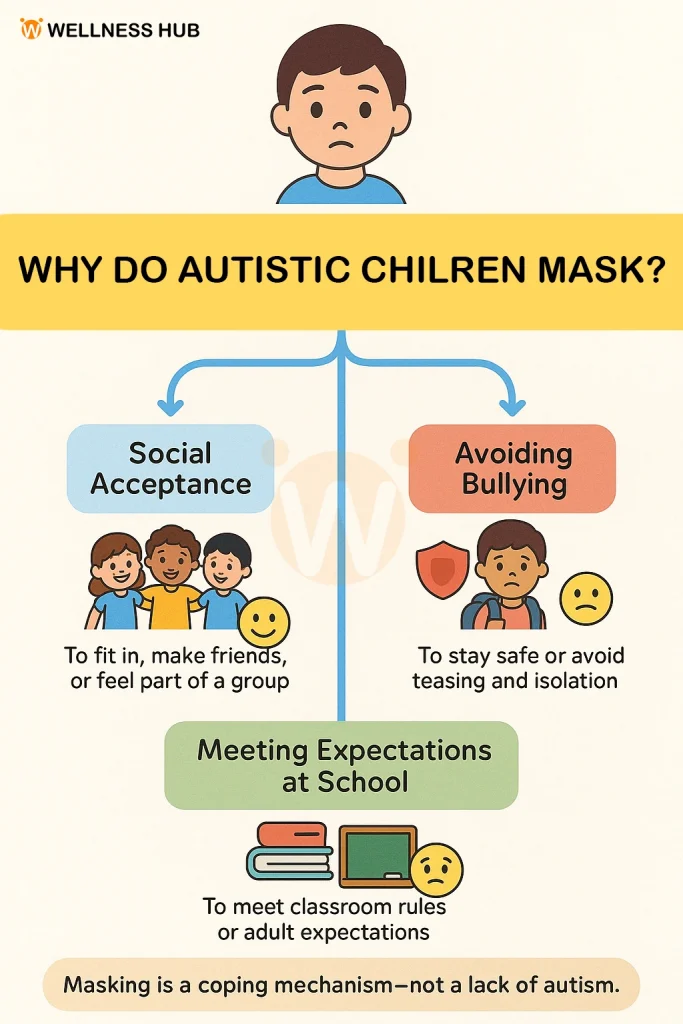
- Social Acceptance: Many children learn that masking can help them avoid negative social interactions. By hiding traits that might be misunderstood or stigmatized, such as repetitive movements or atypical speech patterns, they often find it easier to make friends and integrate into groups.
- Academic and Social Expectations: Schools often have explicit and implicit behavioral norms. Children with autism might mask to meet teacher expectations and classroom norms to avoid reprimands or to receive praise from adults.
- Self-Protection: Masking can also be a defensive mechanism against bullying. Children who appear different can become targets for bullies, and masking can reduce this vulnerability.
Not sure where to start? Book a free consultation with our expert therapists to better understand your child’s needs.
Signs of Masking in Autistic Children
Recognizing the signs of masking in autistic children can be challenging, as these behaviors often blend seamlessly into the day-to-day activities of the child. However, understanding these signs is crucial to providing the right support. Here, we discuss common behaviors and signs that indicate a child might be hiding autistic traits, along with real-life examples from our experiences at Wellness Hub.
Common Behaviors Indicative of Masking
- Imitating Peers: Children who are masking may frequently copy the behaviors, mannerisms, or speech patterns of their peers. They might mimic others to fit in, even if these behaviors don’t come naturally to them.
- Suppressing Stim Behaviors: Many autistic children engage in stimming because it helps them manage sensory overload, stress, or express excitement. However, those who mask might suppress these behaviors in public to avoid drawing attention.
- Over-preparation for Social Interactions: Some children rehearse or over-prepare for routine social interactions, like ordering food in a restaurant or responding to common greetings. This preparation can be a sign that they are masking their natural responses to manage anxiety about unexpected social demands.
- Avoiding Attention: A child might avoid situations where they are the center of attention, such as speaking in front of the class or participating in group activities, because it’s harder to mask in these settings.
- Social Fatigue: Masking requires significant mental effort. Children who mask may exhibit signs of exhaustion after social situations, needing time alone to recharge more so than usual.
Consequences of Masking
While masking can help autistic children blend into social settings, it’s not without its costs. The emotional and social impacts of masking, often overlooked, can be profound and long-lasting. Understanding these consequences is essential for parents, educators, and therapists to mitigate the negative effects and provide better support.
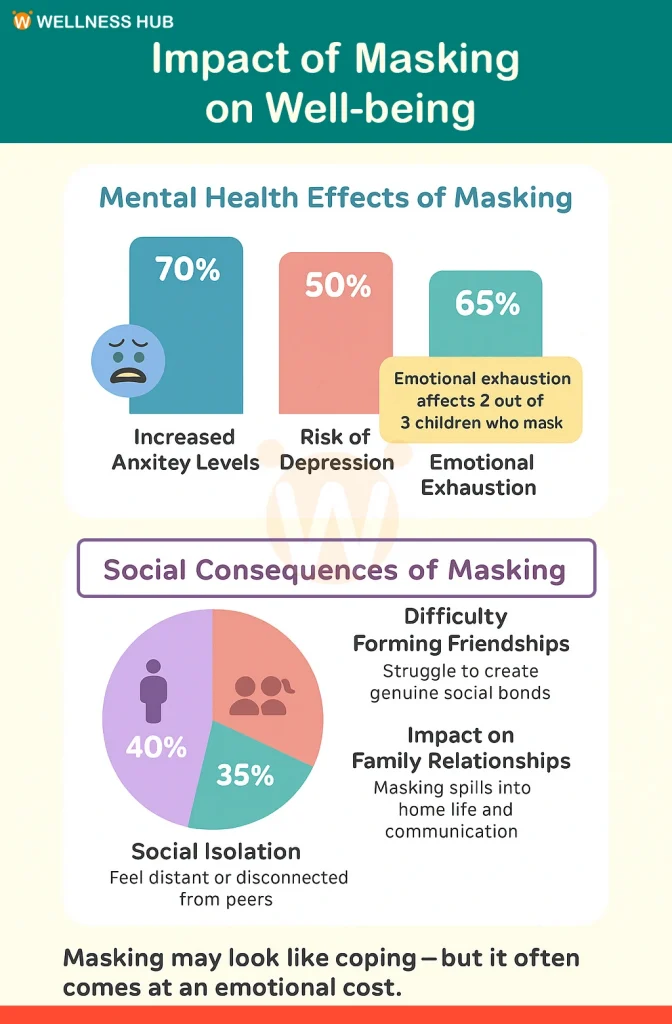
Emotional and Social Impacts
- Increased Anxiety and Stress: Constantly monitoring and adjusting one’s behavior to appear “normal” can lead to significant anxiety. Autistic children who mask frequently might experience ongoing stress, worrying about being ‘discovered’ or slipping up in their performance.
- Suppressed Identity: Masking can suppress a child’s true identity, leading to confusion and low self-esteem. This suppression often makes it difficult for children to form a solid sense of self, which is crucial during developmental years.
- Social Isolation: Even though masking is intended to help autistic children fit in better socially, it paradoxically can lead to feelings of isolation. Knowing they are not interacting authentically can make children feel distant from their peers.
- Difficulty Building Genuine Relationships: Relationships built on masked interactions can feel superficial to the child. They might struggle to connect on a deeper level with peers if they believe their true selves are not accepted.
Long-Term Effects of Continuous Masking
- Burnout: Over time, the effort required to continuously mask can lead to burnout, characterized by emotional exhaustion, reduced performance at school, and a loss of interest in social interactions.
- Development of Mental Health Issues: Chronic stress and anxiety from prolonged masking can contribute to the development of more severe mental health issues, including depression and anxiety disorders.
- Delayed Social Skill Development: Masking can prevent autistic children from practicing and developing their genuine social skills. This delay can impact their ability to navigate more complex social situations as they grow older.
How Parents Can Recognize Masking
Recognizing when an autistic child is masking can be challenging, especially since the signs are often subtle and vary widely from one setting to another. Here, we provide practical tips for parents on how to recognize masking behaviors in autism and what specific signs to look for in different environments such as home, school, and during social gatherings.
Practical Tips for Identifying Masking Behaviors
- Observe Changes in Behavior Across Different Settings: Notice if your child behaves differently when they are at home compared to school or among peers. A child who is significantly more reserved or noticeably different in social settings may be masking.
- Listen for Scripted or Rehearsed Speech: Pay attention to your child’s speech patterns. If their conversation sounds rehearsed or they frequently repeat phrases they’ve heard elsewhere, it could be a sign of masking.
- Monitor Their Response to Social Situations: Children who mask may either withdraw from social interactions or over-prepare for them. They might express undue stress about social events or show relief when they are canceled.
- Watch for Physical Signs of Stress or Anxiety: Masking can be physically taxing. Signs like increased fatigue after social events, headaches, or stomachaches might indicate the stress of masking.
- Check for Inconsistencies in Social Behavior: If your child shows a sudden proficiency in social situations that does not reflect their usual behavior, it might be an indicator of masking.
What to Look for in Different Settings
- At Home:
- Comfort Level: Is your child more relaxed and less guarded? Do they engage in stimming behaviors that they suppress outside?
- Behavioral Shifts: Notice any shift in behavior when a non-family member is present.
- At School:
- Teacher Feedback: Communicate regularly with teachers to learn about your child’s social interactions at school. Are they quiet and withdrawn, or possibly trying to blend in unnaturally?
- Peer Interaction: Observe school events or discuss with educators how your child interacts in group activities.
- During Social Gatherings:
- Participation Level: Does your child seem overly stressed about attending? Do they rehearse how they will interact?
- Post-Event Behavior: Monitor their energy and mood after social events. Exhaustion or relief can indicate the effort of masking.
Supporting Children Who Mask Their Traits
Supporting children with autism who mask their traits is crucial in helping them feel secure and understood. Here we explore effective strategies for support and encouragement, and detail how therapists, particularly those at Wellness Hub, can play a vital role in this supportive framework.
Strategies for Support and Encouragement
- Create a Safe Emotional Environment: At home and school, ensure that the child feels safe expressing their true selves. This includes accepting and celebrating their unique ways of experiencing the world, which can significantly reduce the perceived need to mask.
- Encourage Open Communication: Foster an open line of communication. Let the child know it’s okay to talk about their feelings and that they won’t be judged for their autistic traits. This might include discussing what makes them comfortable or stressed in social settings.
- Tailor Social Interactions: Customize social settings to suit the child’s comfort level. This could mean smaller gatherings or having a quiet space they can retreat to when overwhelmed, helping them engage without the strain of masking.
- Educate Peers and Educators: Awareness and understanding among peers and educators are vital. Workshops or sessions that explain the diversity of the autism spectrum can promote a more accepting and inclusive environment.
- Promote Strength-Based Activities: Engage the child in activities where they can excel without feeling the need to conform. This builds confidence and shows them that their natural abilities are valued and appreciated.
The Role of Education and Awareness
Educating teachers, parents, and peers about the realities of masking in autism is a critical step in creating environments where autistic individuals can thrive. Awareness is a powerful tool that can foster empathy, reduce stigma, and encourage supportive interactions. Let’s explore how education and awareness of autism and masking behaviors can lead to positive changes in both community and individual levels.
Importance of Educating Teachers, Parents, and Peers
- Understanding Unique Challenges: Education helps everyone understand the unique challenges faced by autistic individuals, particularly those related to masking. It shifts the narrative from misunderstanding and misinterpreting behaviors to recognizing and respecting the needs behind these behaviors.
- Promoting Empathy and Support: When teachers, parents, and peers understand why an autistic child might mask their traits, they are more likely to respond with empathy rather than judgment. This empathy can transform the child’s educational and social experiences.
- Reducing Stigma: Knowledge dispels myths and misconceptions about autism. By educating the community, we can break down the barriers and stigma that often isolate autistic individuals.
- Encouraging Appropriate Support: With proper education, parents and educators can implement more effective strategies tailored to the needs of autistic children, reducing the need for masking.
How Increased Awareness Can Make a Positive Difference
- Enhanced Inclusion in Schools: Schools with a high level of autism awareness are better equipped to integrate supportive practices into their classrooms. This includes adapting teaching methods, offering sensory-friendly learning environments, and providing clear communication that respects all students’ learning needs.
- Improved Social Interactions: Peers who understand autism are more likely to be supportive and inclusive in their daily interactions. Awareness fosters a community where differences are not just acknowledged but celebrated.
- Empowered Parents and Caregivers: Educated parents are more equipped to advocate for their children’s needs. They can better navigate the support systems available and collaborate effectively with educators and therapists.
- Policy and Community Impact: Broad awareness can influence policy-making and community services, leading to more resources and better support structures for autistic individuals and their families.
Conclusion:
Understanding and supporting autistic children who mask their traits is crucial. It helps them feel safe and accepted, allowing them to express themselves freely. At Wellness Hub, we provide tailored support and resources to guide and educate families and educators. By creating a nurturing environment, we can reduce the need for masking and enhance the development of these incredible children.
Frequently Asked Questions:
1. What is masking in autism?
Masking is when an autistic child hides or suppresses their natural behaviors to fit into social norms, often to avoid negative reactions from others.
2. Why do autistic children mask their traits?
Autistic children may mask to avoid bullying, fit in with their peers, or meet expectations at school, which makes them feel more accepted socially.
3. How can I tell if my child is masking their autism?
Look for signs like rehearsed speech, avoiding attention, or seeming unusually stressed after social events. These may indicate your child is masking.
4. What are the emotional effects of masking on autistic children?
Masking can lead to anxiety, stress, and a feeling of isolation, as the child might feel they cannot be their true self around others.
5. Can masking affect my child’s school performance?
Yes, the effort to mask can be exhausting and distracting, which might affect your child’s ability to focus and perform well in school.
6. What can teachers do to support students who mask their autism?
Teachers can create a supportive environment that celebrates diversity and includes clear, consistent routines, helping reduce the need for students to mask.
7. How does Wellness Hub help children who mask their autism?
Wellness Hub offers resources and personalized support to help reduce the need for masking, fostering environments where children can express themselves freely.
8. What should I do if I think my child is masking their autism?
Talk to a professional, like a therapist or counselor, who can provide guidance and strategies to support your child in being their authentic self.
9. Are there long-term consequences of masking autism?
Yes, prolonged masking can lead to mental health issues, such as depression or anxiety, and affect the child’s self-esteem and identity.
10. How can I help my child feel comfortable not masking their autism?
Encourage open communication, validate their feelings, and involve them in activities where they can succeed and feel valued for their unique self.
About the Author:
Rajini Darugupally
M.Sc., Speech-Language Pathologist (9+ years of experience)
Rajini is a passionate and dedicated Speech-Language Pathologist with over 9+ years of experience, specializing in both developmental speech and language disorders in children and rehabilitation in adults. Driven by a desire to empower each individual to find their voice, Rajini brings a wealth of experience and a warm, genuine approach to therapy. Currently, at Wellness Hub, she thrives in a team environment that values innovation, compassion, and achieving results for their clients.
Book your Free Consultation Today
Parent/Caregiver Info:
Client’s Details:
* Error Message
